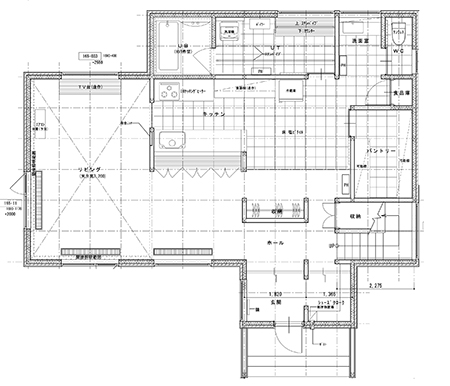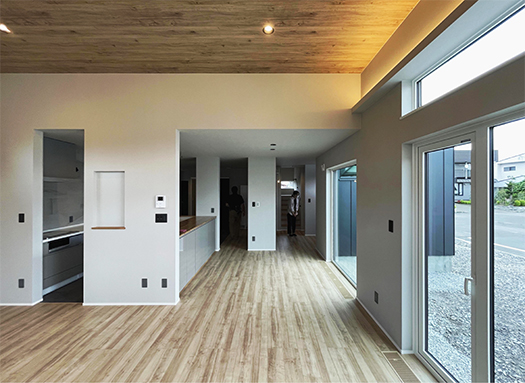


北海道の工務店グループ・アース21の久しぶりの地方現場見学会。
これまで大体年に5−6回のペースで行われてきた
「イマドキ北海道の家」現場見学の貴重な機会。
Zoomやオンラインでの情報交換会もそれはそれで意義があるけれど、
住宅って言うのは空間を創造する人間営為なので、やはり
カラダで感じる気付きや感覚がまさにコアの部分だと思います。
コトバでは伝わらない核心部分はそういった領域であって
それをお互いに確かめ合いながら、研鑽を積んでいくことが重要。
同じ北海道内でも、いくつか地域的な風土の違いがあって
そのなかでもっとも寒冷でしかも多雪という条件下にあるのが旭川・道北。
それだけに高断熱高気密・住宅性能の要件が決定的な地域性。
北海道の住宅研究組織「北総研」も本部が旭川にある。
そうした旭川の家づくりの中核メンバーの最新動向であります。
1軒目は(株)創樹さんの美瑛の家。
わたしのブログでは本州地域などの伝統的古民家などの取材が多いのですが
そういった探訪と対比的にイマドキの北海道の家の違い。
暮らし方の部分での大変革があったのだということが明瞭。
端的には和室がほぼ北海道では消えてしまって、
現代の「世界標準」の暮らし方に準拠した家づくりだと思える。
約25坪弱の1階間取り図を掲載しましたが、
基本的には開放的な間取りが特徴と言えるでしょうか。
玄関入り口は外部から若干の高低差が付けられ、しかも
囲うように屋根・壁が張り出して雪対策としている様子がわかる。
外壁には耐候性を考慮して金属外皮が採用されている。
凹凸の少ないシンプルな外観形状で、屋根は陸屋根でフラットルーフ。
落雪配慮よりも合理的な「乗っけたまま」の雪対応。
屋根の小屋組で剛性を高めるのが150年の北海道の寒冷地住経験の一般解。
これは非常に重要な変化要素だけれど、よくエトランゼのみなさんから
「屋根、ないんだ・・・」と驚かれることがある。
屋根を省力すると、外観的な「バランス」要素は窓の配置が大きくなる。
四角い外観に対して表情を演出していくのは窓となるのですね。
敷地が比較的に大きめでクルマ駐車スペース的には2台が標準的。
雪のことを考えて塀は存在せず、庭もあまり「付随的」とは言えない。
そして室内では基本的に「間仕切り壁」というのは消えていく。
というのは室内の空気環境をコントロールし、均質な室内気候を
実現していくためにはワンルーム感覚の方がハンドしやすくなる。
「動線」はあるけれど「廊下」というハッキリしたゾーン分けは乏しい。
玄関で靴は脱ぐけれど、やはり「世界標準」的ライフスタイルと思えますね。
English version⬇
Biei House Asahikawa 2022 House Building Exploration-1
A “world standard” lifestyle realized after 150 years of exploration of Hokkaido’s living environment. A simple-is-best philosophy to cope with the difficulties of winter snowfall. Biei, Hokkaido
This is the first regional site tour in a long time for the Hokkaido construction company group Earth 21.
The tour has been held approximately 5-6 times a year so far.
This is a rare opportunity to see the “Imadoki Hokkaido House” site tours, which have been held approximately five to six times a year.
While Zoom and online information exchange meetings are meaningful in their own right
However, since a house is a human activity to create a space, it is important to have the
I believe that the core of the process is the awareness and sensation that we feel in our bodies.
It is in these areas that the core cannot be conveyed by words.
It is important to study and study while mutually confirming this.
Even in Hokkaido, there are some regional differences in climate.
Asahikawa and northern Hokkaido have the coldest climate and the most snowfall.
Therefore, the requirements for high thermal insulation, high airtightness, and housing performance are critical in this region.
The Hokkaido housing research organization “Hokusoken” is also headquartered in Asahikawa.
Here are the latest developments of the core members of Asahikawa’s house-building community.
The first house is Souki’s house in Biei.
In my blog, I often cover traditional old houses in the Honshu area.
In contrast to such explorations, there was a big difference in the way of living in Hokkaido.
It is clear that there has been a great change in the way of living in Hokkaido.
In short, Japanese-style rooms have almost disappeared in Hokkaido.
The house seems to be built in conformity with the modern “world standard” way of living.
I have included a floor plan of the first floor of the house, which is just under 25 square meters in size.
Basically, I would say that it is characterized by an open floor plan.
The entrance is slightly elevated from the outside, and
The roof and walls are designed to protect the house from snow.
The exterior walls have a metal skin for weather resistance.
The exterior shape is simple with few irregularities, and the roof is flat with a flat flat roof.
Snowfall considerations are more rational than snowfall considerations, and the snow response is “leave it on”.
Rigidity is increased by the roof’s shed structure, which is the general solution based on 150 years of experience living in cold regions in Hokkaido.
This is a very important change factor, but I often hear from people in Etranse
I am often surprised by the fact that they do not have a roof.
When the roof is reduced in size, the “balance” element of the exterior is the arrangement of the windows.
So it is the windows that create expression to the square exterior.
The site is relatively large, and two cars are standard in terms of car parking space.
There is no fence for snow, and the garden is not very “incidental.
And indoors, “partition walls” will basically disappear.
This is because in order to control the indoor air environment and achieve a homogeneous indoor climate
It is easier to handle a single room in order to control the indoor air environment and to realize a homogeneous indoor climate.
Although there is a “line of flow,” there is not a clear division of “corridor” into zones.
Shoes are taken off at the entrance, but it still seems to be a “world standard” lifestyle.
Posted on 9月 3rd, 2022 by 三木 奎吾
Filed under: 住宅取材&ウラ話, 日本社会・文化研究







コメントを投稿
「※誹謗中傷や、悪意のある書き込み、営利目的などのコメントを防ぐために、投稿された全てのコメントは一時的に保留されますのでご了承ください。」
You must be logged in to post a comment.